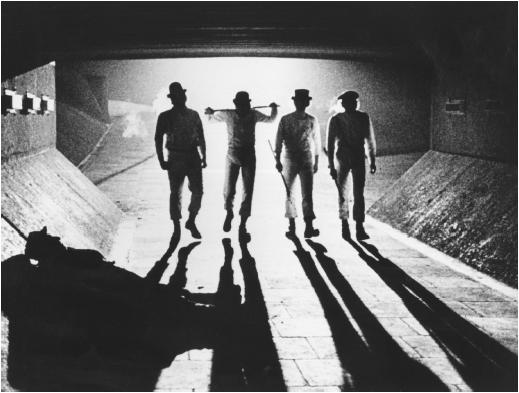
In spite of a varied and rich career in front of the screen, Fred Astaire will perhaps always be most remembered for his partnership with Ginger Rogers in the 1930s. It seems the audience knew it even then, if box office statistics are anything to go by. I say this because the one time Fred decided to break away and make a Ginger-less film, it sunk.
Up till this day I'm pretty sure that this 'infamous' film - A Damsel in Distress - is still most well known for being the only one out of Astaire's 1930s output to lose money at the box office. However, with its steady 7.0 imdb rating and its availability on TCM, perhaps all is not lost with this somewhat obscure gem.
The opening title sequence alone promises that this film will deliver. Aside from Fred Astaire, you have a strong supporting cast led by the beloved partnership of George Burns and Gracie Allen. You also have Joan Fontaine who would later become an accomplished actress most famous for Hitchock's Rebecca. Joan was only beginning her career at this point and in addition, she wasn't a trained dancer. So consequently, as people have noted, she seems like a fish out of water in this musical. Nonetheless, it's always intriguing to see actors in pre-stardom roles.
Then there is George and Ira Gershwin, composer and lyricist respectively of the film's soundtrack. George Gershin wanted to be considered as a serious composer at the time, meaning he didn't only want to be working for money, but also wanting to compose for art's sake. Thus, he rarely composed for film musicals. I think due to the sophistication of George's music and Ira's well fitting lyrics, the film has a touch of elegance. The songs 'A Foggy Day' and 'Things Are Looking Up' are particularly beautiful and romantic.
The other major drawcard of the film is the director, George Stevens. At this point he'd already proved his ability with the Katharine Hepburn vehicle
Alice Adams and with a previous Astaire-Rogers film
Swing Time. In his pre-war career he was an accomplished director of comedy which you see in the film through a lot of light moments injected into the film with ease.
Once the film gets under way, you find out (or at least I did) that the film lives up to the sum of the talents involved. I can't be objective or elaborate where Fred Astaire is concerned, so I can only say that his great dancing, singing and overall persona is in great form here. George Burns and Gracie Allen establish the fundamentals of their partnership - he is the straight man and receiver of her endearingly loopy personality. Just about all the laugh out loud lines are thanks to them and their delivery. In fact their wonderful exchanges could be devoted to a whole new entry. Here's but one example:
Fred Astaire (to Gracie): What's today [the date]?
Gracie: Well I don't know.
George: You could tell if you look at that newspaper on your desk.
Gracie: [picks it up] Oh this is no help George, it's yeserday's paper.
The other main reason to see this film is for the two wonderful dance numbers between Fred, Gracie and George. As I found out afterwards, Gracie and George did a lot of soft-shoe stuff during their vaudeville years and George even taught tap dancing once. Well it's no wonder then that they dance so well with Fred. The standout is a amusement park number called "Stiff Upper Lip" where they go into this swirly room with slides and distorted mirrors. It's both funny, inventive and a showcase for talent.
The slight letdown of the film is the convulted plot akin to that of the Fred and Ginger films; except minus the charm of the latter. It's a formulaic plot that centres around mistaken-identities and mis-understandings. It's supposed to be funny I guess, but having seen these devices already through Fred and Ginger films, they wear thin. Unfortunately, Fred Astaire and Joan Fontaine don't have the best chemistry -- it's sweet and functional, but it doesn't sparkle.
Their dance number 'Things Are Looking Up', though more often maligned than not, tries to work around Joan's limitations: the garden setting blends in with her and Fred's clothing and they are filmed in medium-to long shot through a kind of low angle. You also don't see Joan twirling around much, but when she does she lands a little off-balanced. She's ok with the leaps, though, and there is some nice choreography framed around her strengths. But again, the dance number doesn't sparkle; it begins and ends with little emotion (one of Ginger's strengths) or technical consistency (which Cyd Charisse had in buckets).
However, I will give the romance one positive. The number 'A Foggy Day' not only utilises a beautiful song, but the cinematography too makes it the most profound moment of the film. It comes at a point where Fred thinks (again) that Joan is in love with him, but what he doesn't know yet is that another misunderstanding has occurred. While Joan looks down at him from her window, he's standing around the garden they danced in the day before. He starts singing in his melodic voice that blends as one with the music, and then he looks around himself, seemingly reminescing. All the while there's a sort of fog/light coming from the sky and it gives the whole sequence a magical look.
So in short, the film is delightful and charming in spite of some flaws. What you come away with is a film that holds up better than its box office stats would have you believe.
 Great films, really great films are hard to come by. Really great films produced in Australia are even harder to come by--lately.
Great films, really great films are hard to come by. Really great films produced in Australia are even harder to come by--lately.


















